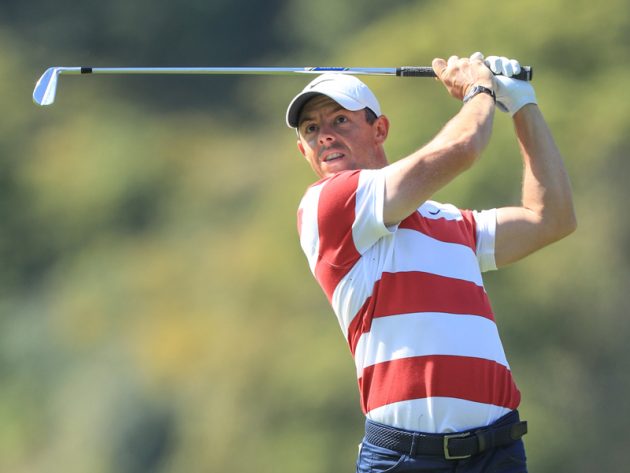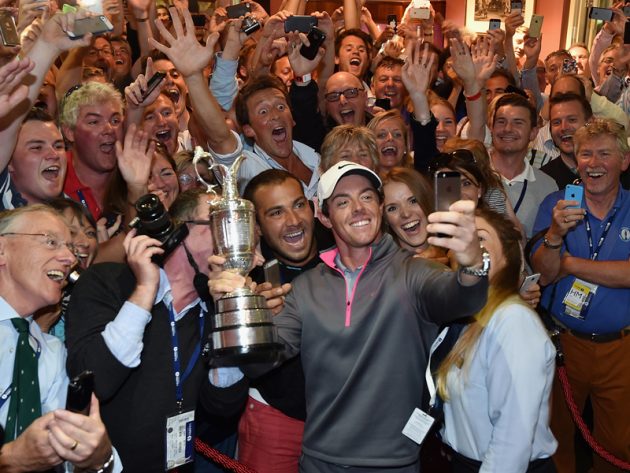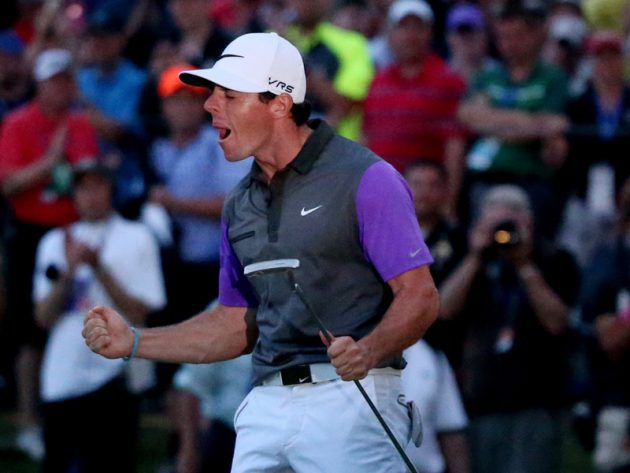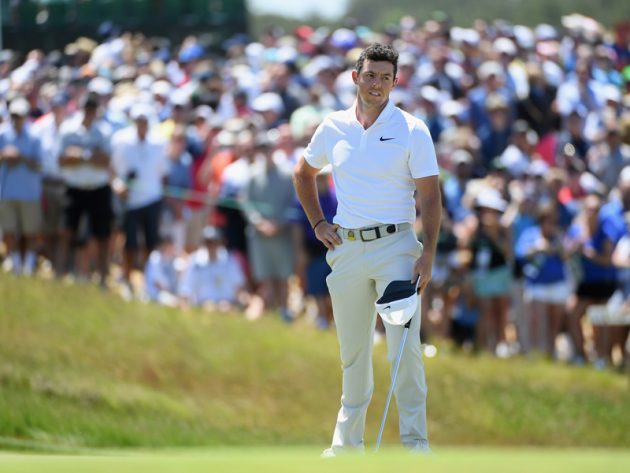'What Next?' - Rory McIlroy Exclusive
After a decade at the top, what does Rory need from the next 10 years to become truly great?


After a decade at the top, what does Rory need from the next 10 years to become truly great?
'What Next?' - Rory McIlroy Exclusive
It’s 2009. Golf’s next superstar is on the verge of squandering a six-shot lead at the Dubai Desert Classic. With two play-off defeats to his name, he’s already got a monkey on his back – incredible, really, given he’s just 19 years old.
The much-hyped youngster from Northern Ireland holds his nerve, just, to win his first European Tour title. Rory McIlroy has arrived.
This is just the start, and everyone knows it.
There’s something different about this player. It’s not just the way he strikes the ball. More impressive, really, is his whole demeanour. This kid looks special.

A decade on and his career is at a crossroads. There aren’t many noteworthy gaps in his CV. The titles have come readily wherever he has played. He’s won most of the big ones, too: The Players, the World Golf Championships and all but one of the Majors. The last of these, however, came nearly six years ago. He’s stalled on four, winless in 20 – too long for a player of his talent.
Subscribe to the Golf Monthly newsletter to stay up to date with all the latest tour news, equipment news, reviews, head-to-heads and buyer’s guides from our team of experienced experts.
If Major victories are the ultimate measure of greatness, where does he stand? The next ten years will determine this.
We’re all willing him on. He’s been a fans’ favourite ever since he burst on to the scene with that curly mop of hair and schoolboy smile. We marvelled at the swing and we enjoyed listening to him, too.
“I’ve been getting interviewed since I was about seven or eight years old. I’m pretty good at this talking thing, I think,” he quipped in a press conference at his first Major (the 2007 Open), where he won the Silver Medal for low amateur. It didn’t take long before he backed up all the hype.
The season following his maiden European Tour victory, he recorded his first win in America.
It came at Quail Hollow, where he made the cut on the number before firing a course-record 62 in the final round to win by four. “He is some kind of player,” said runner-up Phil Mickelson. “He’s 20, but he’s got the game of a veteran. This guy has got all the shots.” He really did, and it sent a message of intent.

At 20, he was the youngest player to win on the PGA Tour since Tiger Woods. The floodgates were about to open.
Which is what happened, sort of, although much like one of his rounds, his career has been a bit of a rollercoaster.
The first dramatic plunge came at the 2011 Masters – the errant tee shot on 10 and the subsequent trip to the cabins among the pines. A blow-by-blow account is not required. We remember it all too well, sadly.
Charl Schwartzel birdied the final four holes, something that often gets forgotten. McIlroy’s collapse was the story; the South African wasn’t supposed to win.
Coming back stronger
It was a chastening experience, yet despite the heartbreak of losing a four-shot lead, he handled the aftermath with real class. Win or lose, he’s rarely anything but.
“I was leading this golf tournament with nine holes to go, and I just unravelled,” he said. “I think it’s a Sunday at a Major, what it can do. This is my first experience at it, and hopefully the next time I’m in this position I’ll be able to handle it a little better. I’ll come out stronger for it.”
And he did. They do say you learn more in defeat than in victory. What is for sure, we learned a great deal about McIlroy over the weeks and months that followed his Masters agony.

In his very next Major start – the US Open at Congressional – he led from start to finish. It was a truly remarkable show of resilience. He lapped the field and, at 22, became the youngest Major Champion since Woods in 1997.
The man from Holywood was the heir-apparent to the great American, of that there was no doubt. He was on an upward curve now. Golf couldn’t have chosen a better role model. Young and compelling to watch, he was the perfect ambassador for the game. He was popular, too, as happy signing Rory wigs for the fans as he was talking openly with the media.
Following the high of the US Open, however, he came back down to earth with a bump after enduring a miserable weekend at Royal St George’s, where he fired rounds of 74 and 73 to blow his chances of a first Claret Jug.
“I’m not a fan of golf tournaments where the outcome is predicted so much by the weather,” he grumbled. McIlroy was – and still is – nothing but forthright.
This became obvious very early on in his career, and it only adds to the intrigue.
In 2009, he labelled the Ryder Cup as “an exhibition” and added, “it’s not that important of an event for me”. The audacity of this young man trying to downplay one of sport’s greatest events.
It caused a stir, but no harm was done. Over time, he’s learned to be more diplomatic, although he still delivers a straight answer. He’s honest to a fault, is Rory, yet his willingness to speak his mind should be applauded. The moment he stops doing so... well, let’s hope that never happens.

The rollercoaster ride continued. Major victory number two came the following season in the USPGA at Kiawah Island. The winning margin, as it had been at Congressional, was eight.
McIlroy was blazing a trail – wherever he went, records tumbled. It was inevitable that the talk should turn to how many Majors he would win. As many as Woods? Even Jack Nicklaus’ haul of 18 was part of the conversation. The following year, however, he went cold – no Majors. A mini crisis was brewing.
For the best in the business, you can’t go too long without winning. Soon, it’s a drought, and questions start getting asked. McIlroy’s struggles were not part of the script.

In January 2013, his place among the sporting elite was confirmed when he signed with Nike. He instantly became one of the highest-paid sports stars in the world, but in his first tournament as a Nike athlete, and with new clubs, he missed the cut. Was there a problem here?
“I wouldn’t look too much into that. If anything, it’s more the Indian than the arrow at this point,” said a typically candid McIlroy.
He was in a different world now, one where everything he said and did was analysed to the nth degree.
In March, he walked off the course after just eight holes of his second round at the Honda Classic, telling journalists he was not in a good frame of mind. He later released a statement citing a painful wisdom tooth. It was largely a season to forget. He’d been built up, but now he was taking some knocks. Well, that’s life at the top for you.
In the end, he answered his critics in the best possible way with victory at the Australian Open. “It has been a frustrating year, but I have worked hard,” he said. “It has been a process, getting back to winning tournaments again.”
It would have been perfectly understandable had he put a finger to his lips as a message to his critics. He didn’t. A puff of the cheeks said it all.
Back in business
It was a sign of things to come, too. The following May, he triumphed at Wentworth.
It wasn’t your run-of-the-mill victory, either, not that McIlroy deals in such affairs. Coming from seven shots behind on the final day – and still dealing with the high-profile split from fiancee Caroline Wozniacki – he fired a 66 to win the BMW PGA Championship by one. We had our Rory back and all was well again.

In July, he was back on the Major trail. The Open was the one many believed he would struggle to win, with his high ball flight and attacking style unlikely to prevail on links layouts. Madness. We should never have doubted him.
It wasn’t quite the exhibition Woods had put on eight years previously at Royal Liverpool, but it was no less impressive.
More was to follow. Just two weeks later, success at the WGC-Bridgestone – which took him back to the top of the world rankings – then a second USPGA title in the near darkness at Valhalla, where he became the first UK player to win back-to-back Majors.

From that moment, talk of the Career Grand Slam was inevitable. It was a long wait until spring and a crack at The Masters, but it was a mouth-watering story that would dominate the build-up. The expectation was huge. The prospect of joining Woods, Jack Nicklaus, Ben Hogan, Gary Player and Gene Sarazen in that exclusive club was huge.
It wasn’t to be. The recording-breaking Jordan Spieth slammed the door shut that year – and it’s been closed ever since. McIlroy finished fourth, which remains his best Masters result. He’s had his chances.
Golfing immortality was within his grasp in 2018, when he teed off alongside Patrick Reed in the final group courtesy of a scintillating 65 on Saturday.
Sadly, he threw in the type of last round – a two-over-par 74 – that we’ve become all too accustomed to seeing. Stats, there’s no escaping them.
In McIlroy’s case, he’s probably sick of hearing about them, even though his numbers are mightily impressive in most departments, most of the time. Last season, on the PGA Tour, he ranked first in Stokes Gained: Off The Tee; first in Strokes Gained: Tee-To-Green; and first in Scoring Average.
He played 19 tournaments, won three times and recorded 14 top-tens. For all his brilliance over the course of the season, however, he struggled for consistency in the Majors: T21 at The Masters; T8 at the USPGA; T9 at the US Open; and a missed cut at The Open – which, of course, was the one that really hurt.
When The Open Championship returned to Royal Portrush for the first time in 68 years in 2019, understandably all eyes were on the home favourite. McIlroy had fond memories of the Dunluce Links, having broken the course record there in 2005 with a 61, aged just 16.

Fourteen years later and his quest for a second Claret Jug was over after his very first tee shot, a pulled iron out of bounds. It was a horrid round, bookended with a quad and a triple.
Then came Friday’s valiant attempt to make the weekend – a 65. You could almost have predicted it, yet it was not quite enough.
“As much as I came here at the start of the week saying I wanted to do it for me, you know, by the end of the round there today I was doing it just as much for them [the fans] as I was for me,” said a shattered McIlroy. “I wanted to be here for the weekend. Selfishly I wanted to feel that support for two more days.”
Mental fortitude
He admitted, too, that it would be “a tough one to get over” – but he did. The following week, he led the WGC-FedEx St Jude Invitational with 18 holes to play after firing a scintillating 62.
Although Brooks Koepka capitalised on a lacklustre McIlroy final-day performance, this was to be one of nine top-tens in his next 11 tournaments.
In November, he claimed a third World Golf Championship and 27th professional win. It’s worth remembering this statistic whenever a tournament slips from his grasp. Should he have won more? Perhaps.

Will he win more? Yes, without doubt – and at the end of his career he’ll boast quite some tally. His WGC victory contributed to his return to the top of the world rankings in February. The Major drought does continue, though, something that isn’t lost on a certain ‘rival’.
Rory vs. Brooks
“I’ve been out here for, what, five years? Rory hasn’t won a Major since I’ve been on the PGA Tour,” Koepka said last October. “So I just don’t view it as a rivalry.”
The American had drawn level with McIlroy on four Major titles after winning the USPGA, yet the Northern Irishman didn’t bite, much. “What Brooks said wasn’t wrong,” he responded. “He’s been the best player for a couple of years, with four Majors. I don’t think he had to remind me I hadn’t won one in a while, but you know.”

That’s not to say words won’t be exchanged further down the line. Golf fans were denied a McIlroy Woods rivalry at the start of the last decade, although it was the latter who was largely responsible for that. McIlroy admits a rivalry would be good for the game, but for that to happen, he’ll need to reverse a few worrying trends.
He used to have the unfortunate tendency of following a fine opening round with a horror show – ‘Freaky Fridays’ they were called. In 2014, out of the 13 tournaments he played before winning The Open, his Friday score was higher on all but three occasions.
“I may be putting a bit too much pressure on myself,” he admitted. “I think I just got into my head.”
In terms of Major performances, since winning the USPGA in 2014 (19 in total having missed the 2015 Open because of injury), it’s not so much the Fridays that have been freaky. In fact, often it’s the opening rounds where he gives the field too much of a head start.

This is certainly the case at the US Open, where he missed three successive cuts between 2016 and 2018, shooting a combined total of 23-over-par for the opening round.
Then there are those weekends where he just flatters to deceive. It’s become part of the package; something we’ve signed up for. As GM columnist Wayne Riley once said, “He’s like a box of chocolates, you just don’t know what you’re going to get.”
He remains box office, and the good news is he may have found the answer if the comments he made after he won a second FedExCup last August are anything to go by.
“I think one of the biggest things is sometimes I try to treat Sundays the same as a Thursday or Friday, and they’re not. I go into them maybe a little too relaxed.”
Perhaps that Brooks guy is just what he needs to get more fired up. Here’s hoping, and here’s hoping for another fantastic ten years. The curly hair may no longer be so voluminous, but at 31 he’s still in his prime. There’s more to come from Rory, much more – you can be sure of that.
Don't forget to follow Golf Monthly on Facebook, Twitter and Instagram.

Michael has been with Golf Monthly since 2008. A multimedia journalist, he has also worked for The Football Association, where he created content to support the England football team, The FA Cup, London 2012, and FA Women's Super League. As content editor at Foremost Golf, Michael worked closely with golf's biggest equipment manufacturers and has developed an in-depth knowledge of this side of the industry. He's a regular contributor, covering instruction, equipment, travel and feature content. Michael has interviewed many of the game's biggest stars, including seven World No.1s, and has attended and reported on numerous Major Championships and Ryder Cups around the world. He's a member of Formby Golf Club in Merseyside, UK.